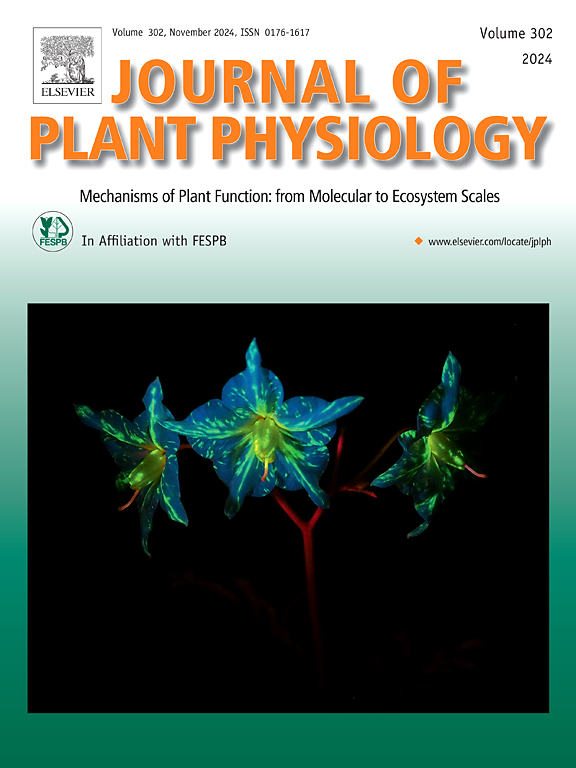Integrative study of subcellular distribution, chemical forms, and physiological responses for understanding cadmium tolerance in two garden shrubs
IF 4
3区 生物学
Q1 PLANT SCIENCES
引用次数: 0
Abstract
Urban ornamental shrubs have significant potential for restoring cadmium (Cd)-contaminated soil. The Cd enrichment characteristics and tolerance mechanisms of Buxus sinica and Ligustrum × vicaryi were investigated through a simulated pot pollution experiment. Specifically, the Cd content and accumulation in different plant tissues, the subcellular distribution and chemical forms of Cd in the roots, and the effects of Cd on the ultrastructure of root cells under various Cd concentrations (0, 25, 50, 100, and 200 mg kg⁻1) were analyzed. The results showed that: (1) As the Cd treatment levels increased, the total biomass of B. sinica gradually decreased, while L. × vicaryi exhibited a stimulation effect at low Cd concentrations but inhibition at high Cd concentrations. (2) The Cd content in different tissues of both shrubs increased with rising Cd levels. The bioconcentration factor (BCF) and translocation factor (TF) indicated that L. × vicaryi has the potential for Cd phytostabilization. (3) Cd in the roots of both shrubs was primarily present in NaCl-extractable form, and was mostly bound to the cell wall. (4) Excessive Cd caused damage to the cellular structure of B. sinica, while the cells of L. × vicaryi maintained normal morphology. (5) In both shrubs, Cd primarily bound to the cell wall through hydroxyl and amino functional groups, as well as soluble sugars. In summary, converting Cd to less active forms, immobilizing Cd in the cell wall, and providing binding sites through functional groups may be crucial resistance mechanisms for both shrubs in response to Cd stress.
两种园林灌木的亚细胞分布、化学形态和生理反应的综合研究,以了解其耐镉性。
城市观赏灌木对镉污染土壤具有显著的修复潜力。通过模拟盆栽污染试验,研究了黄杨和女贞对Cd的富集特性及其耐受机制。具体来说,分析了不同浓度(0、25、50、100、200 mg kg - 1)镉对植物不同组织中镉含量和积累的影响,镉在根中的亚细胞分布和化学形态,以及镉对根细胞超微结构的影响。结果表明:(1)随着Cd处理水平的增加,黄颡鱼总生物量逐渐减少,白颡鱼在低Cd浓度下表现出刺激作用,而在高Cd浓度下表现出抑制作用。(2)两种灌木不同组织Cd含量均随Cd水平的升高而升高。生物富集因子(BCF)和转运因子(TF)的测定结果表明,白蜡草具有稳定镉的潜力。(3)两种灌木根系中的Cd主要以nacl可提取形式存在,且主要结合在细胞壁上。(4)过量的镉对黄杨细胞结构造成损伤,而黄杨细胞形态保持正常。(5)在这两种灌木中,镉主要通过羟基和氨基官能团以及可溶性糖与细胞壁结合。综上所述,将Cd转化为活性较低的形式,将Cd固定在细胞壁上,并通过官能团提供结合位点可能是这两种灌木对Cd胁迫的关键抗性机制。
本文章由计算机程序翻译,如有差异,请以英文原文为准。
求助全文
约1分钟内获得全文
求助全文
来源期刊

Journal of plant physiology
生物-植物科学
CiteScore
7.20
自引率
4.70%
发文量
196
审稿时长
32 days
期刊介绍:
The Journal of Plant Physiology is a broad-spectrum journal that welcomes high-quality submissions in all major areas of plant physiology, including plant biochemistry, functional biotechnology, computational and synthetic plant biology, growth and development, photosynthesis and respiration, transport and translocation, plant-microbe interactions, biotic and abiotic stress. Studies are welcome at all levels of integration ranging from molecules and cells to organisms and their environments and are expected to use state-of-the-art methodologies. Pure gene expression studies are not within the focus of our journal. To be considered for publication, papers must significantly contribute to the mechanistic understanding of physiological processes, and not be merely descriptive, or confirmatory of previous results. We encourage the submission of papers that explore the physiology of non-model as well as accepted model species and those that bridge basic and applied research. For instance, studies on agricultural plants that show new physiological mechanisms to improve agricultural efficiency are welcome. Studies performed under uncontrolled situations (e.g. field conditions) not providing mechanistic insight will not be considered for publication.
The Journal of Plant Physiology publishes several types of articles: Original Research Articles, Reviews, Perspectives Articles, and Short Communications. Reviews and Perspectives will be solicited by the Editors; unsolicited reviews are also welcome but only from authors with a strong track record in the field of the review. Original research papers comprise the majority of published contributions.
 求助内容:
求助内容: 应助结果提醒方式:
应助结果提醒方式:


